The Italianness of Italian Landscape
massa critica | davide tommaso ferrando
The following article is a solicited contribution to State of Exception: a Biennale di Venezia Monditalia Weekend Special curated by Luca Silenzi/Spacelab Architects, to whom I am grateful for the kind invitation. Its publication has been preceded, during the past week, by the publication on my Facebook, Instagram and Tumblr profiles of a series of collages meant to visually reinforce the main thesis of the text. Two of these collages can be found here, as well as two other images specifically produced for this post (one of which is intentionally untrue). My heartfelt thanks go to Tomaso Ferrando, and above all to Paula V. Álvarez, for the precious suggestions given in editing phase.
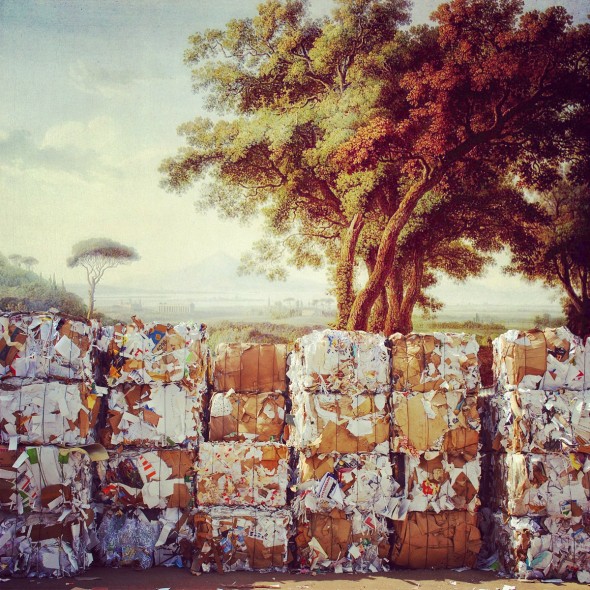 Italian Landscape | 2014
Italian Landscape | 2014
Between the 17th and 18th Century, as it is well known, traveling several months around Europe (and reserving Italy as the crucial destination of the trip) became quite common among the young bourgeoisie and aristocrats of the old continent. Some truly willing to learn from the past, others mainly interested in living an exotic experience, the future members of the ruling class used to spend the final part of their formation years in the cities where the works of the great masters – painters, sculptors and architects – were held. In 1670, Richard Lassel named this new custom “Grand Tour”, from which the actual word “tourism” is obviously derived.
Being the Grand Tour something “unique and to be remembered for the rest of one’s life”1, it is no wonder that during their long trip, these cultivated travelers used to buy several tokens that, once back home, would remind them of the delightful moments spent in the Roman countryside, along the canals of Venezia or in Firenze’s Piazza della Signoria. Not accidentally, the word “souvenir”, from the Latin subvenire (to come to mind), becomes widely used from the second half of the 18th Century.
It is so that a mixture of wealth and nostalgia propelled a new artistic market throughout Italy, as landscape paintings and urban vedute, which idealized the most famous rural and urban settings of the Grand Tour, rapidly became the must-have souvenirs for the rich traveling class. As a consequence, many talented artists moved to Italy to take advantage of the new boom, finding it convenient to specialize in the representation of – what we now recognize as – typical Italian landscapes.
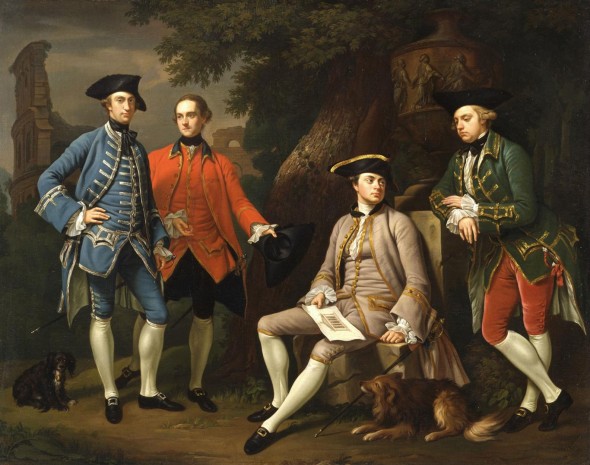 Nathaniel Dance-Holland | James Grant of Grant, John Mytton, the Hon. Thomas Robinson, and Thomas Wynne | 1760
Nathaniel Dance-Holland | James Grant of Grant, John Mytton, the Hon. Thomas Robinson, and Thomas Wynne | 1760
Lorrain, Hackert, Tischbein, Van Wittel, Pannini, Piranesi, Canaletto, Bellotto, Guardi… these are just few of the names of the artists that, during more than a century, forged the appearance of Italian cities and countryside, by means of their paintings and etchings.
I’m writing on purpose “forged”, instead of “documented”, as we must consider – recalling Oscar Wilde‘s famous paradox according to which “Life imitates Art far more than Art imitates Life” – that landscape painters didn’t just represent the beauty of the places they observed: they actually invented it, in the sense that each of their works unveiled an aesthetic dimension of the portrayed environment, introducing and then fixing it into the imaginary of their society.
“Where, if not from the Impressionists – asks Oscar Wilde in The Decay of Lying – do we get those wonderful brown fogs that come creeping down our streets, blurring the gas-lamps and changing the houses into monstrous shadows? To whom, if not to them and their master, do we owe the lovely silver mists that brood over our river, and turn to faint forms of fading grace curved bridge and swaying barge? The extraordinary change that has taken place in the climate of London during the last ten years is entirely due to a particular school of Art”2.
The fact that we perceive reality through art has been widely analyzed by Alain Roger, who maintains that «our eye, even if we consider it empty, is rich and saturated of an abundance of latent models, which are rooted and therefore beyond suspicion: taken from painting, literature, cinema, television, advertising etc., they act unconsciously and forge our experience, perceptive or not»3. This last consideration is of paramount importance here, as it suggests the crucial role played by the images painted by Lorrain, Canaletto, etc., in the formation of our current idea of what a typical Italian landscape is – an idea that usually draws back to those paintings –, and consequentially in the definition of the ways in which we are (usually not) able to act upon it.
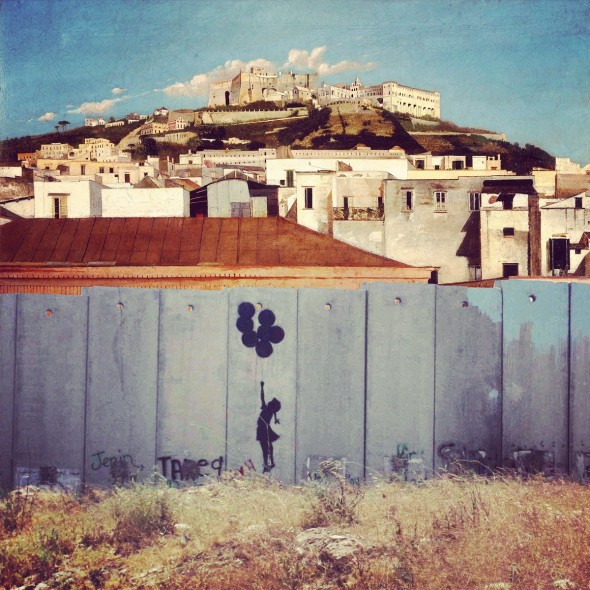 Certosa di San Martino with Castel Sant’Elmo in Naples | 2014
Certosa di San Martino with Castel Sant’Elmo in Naples | 2014
Now, what I’m interested in stressing here, is that the unique amount, beauty and fame of Italian landscapes and vedute painted between the 17th and 18th Century – images that we all know since they are widely exhibited all over the globe (who has never crossed eye with a Canaletto, original or reproduced?) – are partly responsible for the #StateofException in which a constantly growing part of the Italian territory is being held captive, through Law, by City Councils, Superintendencies, and so on.
How else could one explain the fact that every new house built in Sauze di Cesana – a small town situated on the north-western alpine border of Italy – has to be shaped according to an extremely detailed catalog of prescriptions and parameters, all meant to reinforce the vernacular look of the place, no matter how such look is achieved? Sauze di Cesana’s Piano Regolatore Generale tells you how every part of a house should look like, so that a specific imaginary remains forever unchanged. From the definition of floorplan, section and facade, to the aspect of doors, windows, stairs, balconies and roof, the strict control of the Elements of Architecture becomes the way in which a reassuring, “typical” landscape is systematically recreated – although only apparently, as behind these vernacular surfaces carved in stone and wood, dom-ino structures in reinforced concrete are conveniently erected, in order to save money and respond to (other) building regulations. In Sauze di Cesana, architecture is brought down to the level of Le Roy Merlin bricolage: just choose your favorite details from the online catalog, and put them together to make your dream chalet come true.
“Look at it this way: the game of architecture is an intricate play with rules that you may break or accept. These rules, like so many knots that cannot be untied, have the erotic significance of bondage: the more numerous and sophisticated the restraints, the greater the pleasure”4.
I wonder if “pleasure” is the right word to describe what Bernard Tschumi felt last May when he was told that, after several months working on his – quite disappointing – design for the cultural center A.N.I.M.A. (to be realized in a rural area of the Adriatic town of Grottammare), and exactly one day before its construction could actually begin, the Superintendency of Ascoli Piceno blocked the entire project. Why? Because “due to its height and volume, it doesn’t seem to be well integrated in its context, as it conceales the view of the trees (olives and hedges included) that are found at the far end of the valley”. Also, Tschumi’s project was too close to “two characteristic and interesting rural farmhouses, typical of the region’s minor architecture”, and therefore did not permit their undisturbed visual appreciation. As a consequence, the Superintendency asked to lower the building, so that the existing rural landscape could be maintained as untouched as possible – in other words: the best architecture is no architecture at all.
The request of the Superintendency seems even more surprising once you take a Google Street View ride around the “context with agrestic value” – a pleasant although quite ordinary rural area –, and check the state of the two “noteworthy farmhouses” – anonymous ruins with no particular value. Add that, already before the refusal, the Superintendency had already asked Tschumi to introduce several changes to his project, among which the placement of some trees on the roof of the building (apparently, the only request that the French-Swiss architect has refused), and you will realize how preconstructed images are playing a crucial role in this dispute. The superintendent, in fact, offers an illogical interpretation of the word “landscape”, intending it as “the integration between natural and artificial elements” – read: the preservation of the existing aspect. While the architect seems incapable of accepting the only restriction – the trees on the roof – that would substantially change the original aspect of his design. But wasn’t architecture precisely about transforming restrictions into opportunities?
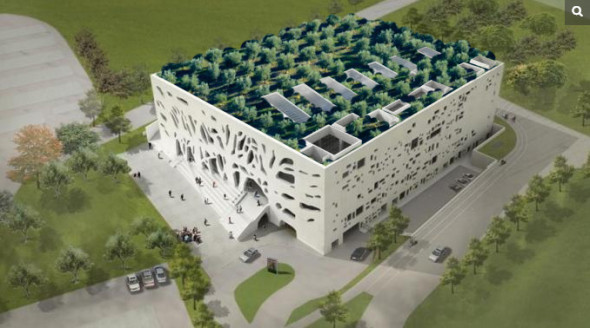 What if Tschumi had accepted all the requests of the Superintendency?
What if Tschumi had accepted all the requests of the Superintendency?
The case of A.N.I.M.A. moves the scope of this essay towards the – to me extremely fertile – region in which architecture and law meet. In a recent issue of “Volume”, Liam Ross has interestingly stressed that:
“The innovative potential of any discipline is not commensurate to the autonomy or “artistic freedom” that it offers its practitioners, bur rather to the points of contact that it maintains, the degree of friction that it can generate, with respect to the “everyday frame of life” it operates within. […] the possibility of creativity is always correlative to the nature and extent of established norms”5.
In other words: invention and experimentation can be defined as creative responses to normative issues. Two quick examples from Holland:
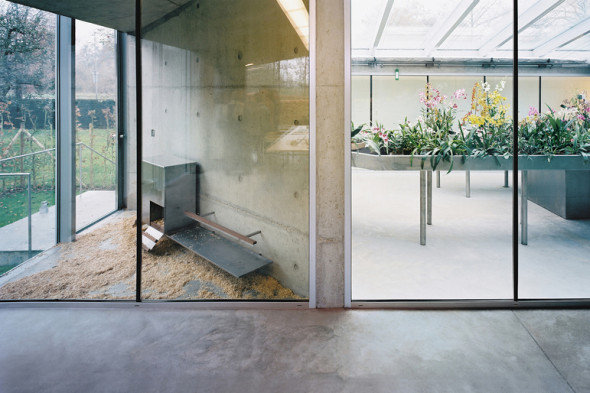 Wiel Arets | Hedge House | 2001 © Wiel Arets Architects
Wiel Arets | Hedge House | 2001 © Wiel Arets Architects
In order to build an art gallery on a protected plot beside a Dutch castle, where “working garden” was the only function allowed, Wiel Arets has integrated a chicken coop, a tool shed and a greenhouse in the project, thus not only managing to actually build the art gallery, but also creating a unique programmatic combination that, otherwise, would have not been conceived.
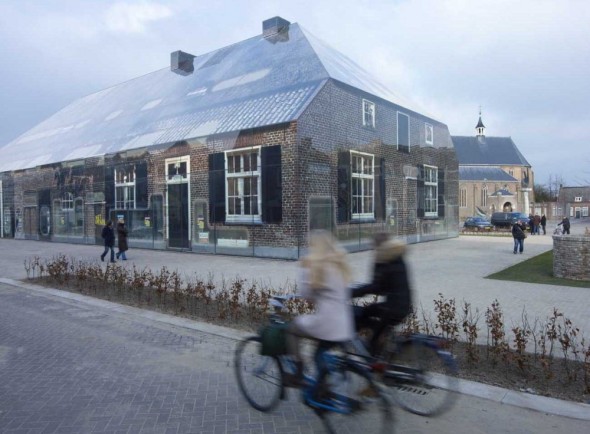 MVRDV | Glass Farm | 2013 © Jeroen Musch
MVRDV | Glass Farm | 2013 © Jeroen Musch
Albeit restrictions on program (a farm), materials (brick) and volume (that of a typical farmhouse), MVRDV has managed to build a commercial glasshouse in the central square of the Dutch town of Schijndel. How? By printing on the transparent envelope of the building a collage of brick facades of typical Dutch farmhouses, therefore delivering to the citizens the image, not the architecture, they expected – which worked out well.
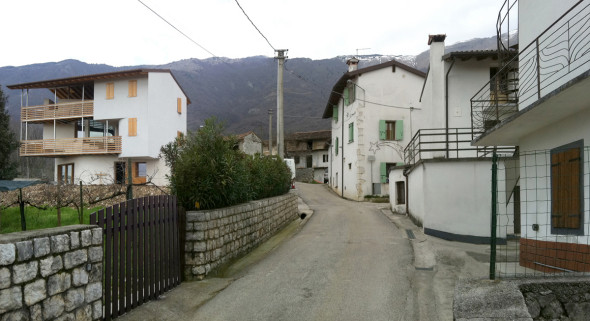 ELASTICOSPA | Learning from Venturi who learned from Las Vegas | 2013 © Betta Crovato
ELASTICOSPA | Learning from Venturi who learned from Las Vegas | 2013 © Betta Crovato
Italy is not Holland, of course, where a crucial capacity to think and accept the unexpected, especially when it comes to architecture, seems to be more widely rooted among designers, clients and legislators. From time to time, nevertheless, exceptions can also be found in the Belpaese, like in the interesting case of a small private house recently completed by ELASTICOSPA in the town of Polcenigo, in the North-East of Italy. Here, building regulations imposed a very strict geometry for the facades overlooking the street, with the usual aim of preserving the vernacular look of the place, while less prescriptions were given for the inner part of the plot. In a critical response to this planning schizophrenia, the building is the result of the collision of two very different parts: an ordinary front, literally designed according to building regulations; and an extraordinary rear, in which the traditional elements of vernacular architecture (the window, the balcony, the roof) are defaced in order to show the formal and spatial potential they can have, once they are freed from the constraints of regulations aimed at controlling their appearance, rather than their substance.
The inherent ambiguities of preservation have been weel brought to the fore by OMA‘s 2010 Cronocaos exhibition, in which modernity’s traditional lack of interest towards the past is deemed responsible for the actual absence of theories capable of managing such dangerously growing phenomenon. According to Koolhaas:
“Embedded in huge waves of development, which seem to transform the planet at an ever-accelerating speed, there is another kind of transformation at work: the area of the world declared immutable through various regimes of preservation is growing exponentially. A huge section of our world (about 12%) is now off-limits, submitted to regimes we don’t know, have not thought through, cannot influence. At its moment of surreptitious apotheosis, preservation does not quite know what to do with its new empire”6.
I don’t think there’s much to add to this excerpt, as the trend hasn’t really changed in the past four years: everyday more, and at a global scale, preservation invades and occupies the territories of transformation, slowly but inexorably reducing our freedom to shape the world according to our culture and needs.
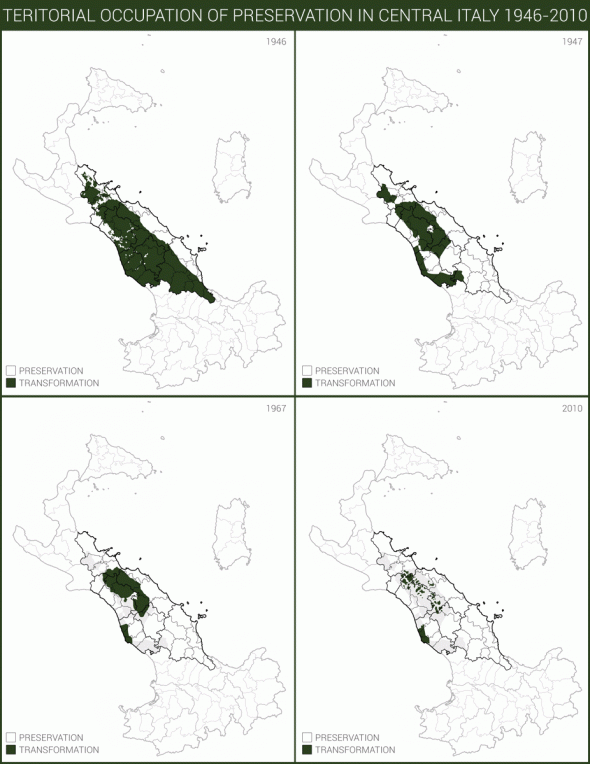 Map of the territorial occupation of preservation in central Italy 1946-2010 | 2014
Map of the territorial occupation of preservation in central Italy 1946-2010 | 2014
Once observed from OMA’s point of view, therefore, the Italian case stands as just one among many examples of a global trend towards preservation that, at least for the moment, seems fairly unstoppable. After all, “Like the steam engine – we find written in Content (2004) – preservation is an “invention”, in fact is part of the repertoire of inventions that define modernization. The past is only an issue when the future is being constructed. The apparent collision between preservation and modernity has disrupted our discourse on the city. Preservation is an integral part of modernization”7. Period.
And still, should I look for some kind of Italian specificity on the matter, and should I put it in relation with the underlying theme of this text (the power of images), I would probably insist on the widespread imposition of highly restrictive design rules on otherwise unsuspected territories: rules whose only concern, tellingly, is the perpetration of a certain kind of historic image – that of a typical Italian landscape – at all costs.
“The triumph of visual culture obliterates all complexities, freezing the synaesthetic emotions and the psychological dimension. It is the absolute visual supremacy that has determined the reduction of landscape to a spectacle to be consumed […]. The society of the spectacle has produced themed landscapes as a new commodity to compensate the devastating internalization of consumption. […] But what is this landscape, this empty word that echoes in our times as a sweet solution to all problems? Oh, how beautiful these Italian landscapes are! […] They are so beautiful that we must save them. We must preserve them, embalm them, protect them!”8.
Inside the areas occupied by preservation, wealth is generated through the trade of frozen cultural identities. Outside of them, land speculation is encouraged by mindless legislation. By making explicit the bound that ties landscape and commodification together, Marco Navarra brings us back to where this text started, that is to the sale of our territory, in the form of beautiful images – on canvas or for real, it doesn’t matter.
Isn’t precisely this nostalgic, pre-industrial look, what the global market of tourism still expects from Italian cities and countryside? So, why should ministers, superintendents or clients be interested in transforming our territory, if such expectations are worth a fortune? The preservation of national landscape is one more effect of the commodification of national identity: under the pressure of globalization, local authorities need myths to hang on to, in order to attract their share of investments, while myths need words and images to become real, and therefore to seduce us. The grotesque laughter of Francesco Piscicelli during the L’Aquila hearthquake in 2009, in view of the money that the reconstruction phase would have brought to his pockets, is an extreme example of the ambiguous relations that cultural constructs such as “landscape” are capable of generating: as far as they are are worth some good money, let’s keep these reassuring images exactly as they are. But as soon as the occasion is given, let the construction begin.
Davide Tommaso Ferrando
Notes:
[1] CESARE DE SETA, Vedutisti e viaggiatori in Italia tra Settecento e Ottocento, Bollati Boringhieri, Torino 1999, p. 17.
[2] OSCAR WILDE, La decadenza della menzogna, Filema, Napoli 2006, pp. 105-125.
[3] ALAIN ROGER, Breve tradato del paisaje, Biblioteca Nueva, Madrid 2007, p. 20.
[4] BERNARD TSCHUMI, Advertisements for Architecture, 1977.
[5] LIAM ROSS, Just Joking, in “Volume” 38, 2013, p. 136.
[6] REM KOOLHAAS, Cronocaos, Biennale di Venezia, 2010.
[7] REM KOOLHAAS, Content, Taschen, 2004, 458-459.
[8] MARCO NAVARRA, Abiura dal paesaggio, Il melangolo, Genova 2012, pp. 35-36.
Related Posts
Questo sito usa Akismet per ridurre lo spam. Scopri come i tuoi dati vengono elaborati.

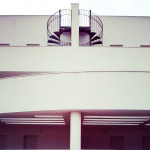

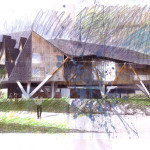




Lascia un commento